BitterSweetBrews
Tim Trabold
I have a couple quick water questions:
1. I use RO water. When building up my water for 3 vessel brewing I use different additions for strike and sparge water based on either Beersmith or BrunWater. I have pretty much converted to mostly BIAB. I am wondering how that changes the way I add salts. Are there things I should shy away from since I am adding all the water at once?
2. I always throw a campden tablet into my strike and sparge water as insurance against chloramine. Usually this is around 10 gallons. I have been gathering RO water in 5 gallon buckets for this weekends big brew, so far 30 gallons. Without really thinking i threw a campden tablet into each bucket. Is that going to be too much and have any bad effects? Doesn't sodium metabisulfate retard fermentation?
Thanks,
Tim
1. I use RO water. When building up my water for 3 vessel brewing I use different additions for strike and sparge water based on either Beersmith or BrunWater. I have pretty much converted to mostly BIAB. I am wondering how that changes the way I add salts. Are there things I should shy away from since I am adding all the water at once?
2. I always throw a campden tablet into my strike and sparge water as insurance against chloramine. Usually this is around 10 gallons. I have been gathering RO water in 5 gallon buckets for this weekends big brew, so far 30 gallons. Without really thinking i threw a campden tablet into each bucket. Is that going to be too much and have any bad effects? Doesn't sodium metabisulfate retard fermentation?
Thanks,
Tim



